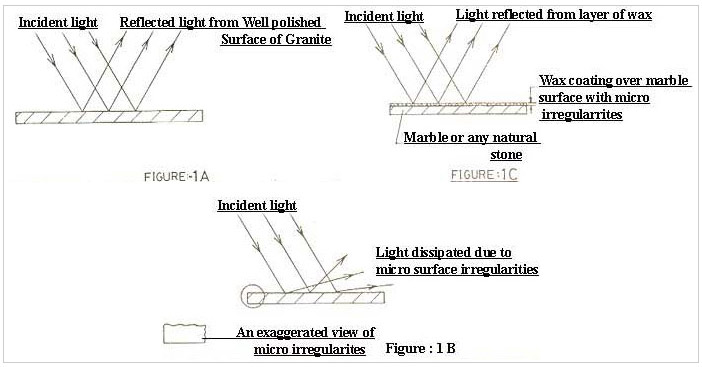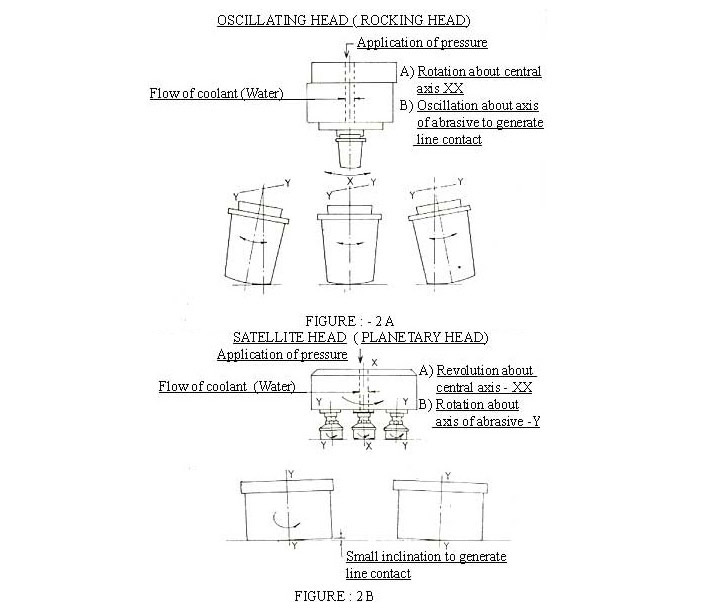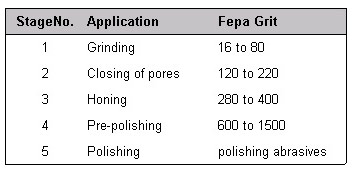1. Selection Of The Sequence Of Abrasives (For Polishing Granite)
It is very important that the initial grinding be carried out thoroughly with the rough grits in order to make the surface of the granite absolutely flat. It is important to remember that the quality of the polish depends entirely on the quality of the flatness achieved by the initial grinding and honing process. Many a times, operators ignore the first two stages and concentrate on the application of the polishing abrasives in an attempt to get a high gloss, but this will not help unless the grinding and closing of the pores of the granite is carried out successfully.
2. Selection Of The Bond Of Abrasives
The selection of the bond of the abrasives depends on the sawn surface of the granite,the quality of granite and the production rate required. In general, soft bond abrasives will give a faster rate of production and are normally used for polishing monuments & tiles. Hard bond abrasives last longer and are extensively used in the polishing of rough gang sawn slabs where the wear and tear of the abrasive is excessive.
3. Required Polishing Pressure
The grinding pressure determines the rate of material removal. However, excessive grinding pressure may cause burn marks, scratches, breakage of granite slabs/abrasives. Normally hard and porus granites like Red Granite require higher pressure as compared to softer granites like black granite. The pressure also depends on factors like Conveyor Speed, Bridge Speed, type of machine, type of abrasive etc.
4. Adequate Water Supply
Adequate flow of water is a must for good grinding, honing and polishing. A copious supply of water will ensure good surface preparation and will inhibit burn marks and scratches. The finer mesh abrasive should preferably have a supply of fresh water to ensure scratch free polish.
The belt speed in the Line Polishing Machine and the number of passes in the Bridge Polisher will determine the quality of polish as well as the rate of production. In Line Polishing machines the belt speed should be restricted to a level where a clear and acceptable polish is achieved. Higher speeds than required, may cause uneven polish, bum marks, scratches, dullness etc. Likewise, the Bridge polisher should also have adequate number of passes to ensure complete grinding and polishing.
Ceramic Polishing
The polishing of Ceramic Tiles involves a different bond as well as a different application of abrasives. Ceramics are much harder than granite and therefore require a suitable bond for grinding and polishing. At the same time it is necessary to achieve the optimum cost per sq. mtr. to ensure the economy of polishing.
Life of Abrasives
The cost per sq.mtr. is a very important criteria when evaluating the performance of abrasives. The individual price of the abrasive is of little consequence since the abrasive which has a higher initial price may also give substantially higher life and hence only the cost per sq. mtr. is of significance. It is also important to remember that very hard abrasives which give a low cost per sq. mtr. may not be grinding or polishing at the required rate of production, thus giving a low level of productivity. Hence, when comparing the performance of the abrasives the cost per sq.mtr. as well as the rate of production has to be kept in mind.
To achieve excellent results, the application of the correct grades from coarse to fine has to be masterfully accomplished. The technicians (Machine Operators) should have a good understanding of the various types of natural stones and must vary the grades of the abrasives according to the sawn surface of the stone.


